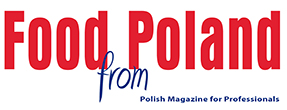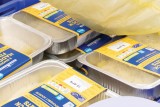The confectionery market is extensive, encompassing many categories such as cakes, gingerbread, chocolates, wafers, gum, jellybeans, dragees or challah. Such a wide choice contributes to the high number of transactions. It is worth mentioning that, on average, 1 transaction contains 2 different packages of sweets, which, according to CMR calculations, means that approximately 10,000 packages of products from this segment are sold every minute.
Market condition
The confectionery market is growing due to consumption volumes. According to NielsenIQ, from July 2022 to August 2023, the sales value of a basket of chocolate confectionery increased by 19.7% year-on-year. The institute took into account the categories of cakes, pralines, chocolate bars, impulse wafers, impulse bars, ready-to-eat cakes, chocolate kits and figurines, jimmies, muesli bars and power balls/truffles.
According to Euromonitor International, this increase is mainly due to inflation. Rising raw material and energy costs have caused some companies to raise the prices of the sweets they offer. Despite this, there is still a demand for the products in question, thus volume sales are growing, albeit more slowly than value sales.
NielsenIQ indicates that from July 2022 to August 2023, volume sales expressed in kilograms increased by 1.3% y-o-y. and reached a value of 404.409 million kg. During the period under review, sales in terms of volume also increased by 5.5 per cent compared to the previous corresponding period and amounted to 3.829 billion units.
Three categories are responsible for more than half of the market. The largest of these are biscuits, which, according to NielsenIQ, accounted for 23.9% of sales of the entire confectionery basket in the period July 2022-August 2023. Pralines came second, accounting for 17.7% of the market share in the period under review, with chocolate bars accounting for 17.3%. As CMR adds, functional bars, flavoured jellies and chewing gums recorded large increases in sales value in 2023.
For a better mood
What is probably most associated with sweets is chocolate – in the form of bars, chocolate bars, as a topping for wafers or as a topping for chocolate chips. It is one of the most popular categories of sweets, the consumption of which has remained stable in Poland for years.
According to the report „World and Polish chocolate market 2023”, carried out by E.Wedel, Poles eat an average of 5.8-5.9kg of chocolate per year. The authors of the study forecast that consumption will grow to reach 6.4kg in 2028.
For many consumers, chocolate sweets are a recipe for a good mood – available at affordable prices, they provide a moment of pleasure and have a stress-relieving effect. This is borne out by the findings of Mintel research, according to which 74% of respondents report that this type of sweet improves their mood.
According to Kantar data from April 2021 to March 2022, 74.82% of 15–75-year-olds consume chocolate bars. Of these, 32% do so 2-3 times a month and 26% once a week. The same percentage of respondents reach for chocolate bars once a month or less often. The smallest group are those who consume it more often than once a week – a response given by 15% of respondents declaring to consume chocolate in bars.
The trouble with cocoa
The cost of chocolate confectionery has been rising since 2023. According to the ‚Retail Price Index’ report by UCE Research and WSB Merito, in March/April 2024, products containing cocoa became over 10% more expensive year-on-year. This is due to increases in the price of cocoa, which – despite its already high price – continues to rise.
This is mainly due to poor yields in Africa, which is the main global supplier of cocoa fruit seeds. Poor yields are the result of climatic problems (cocoa is not resilient to weather changes) and declining numbers of plantations. UNCTAD predicts a cocoa shortfall of 374,000 tonnes this year, compared to 74,000 tonnes last season.
When the price of cocoa rises, the price of chocolate confectionery automatically increases – and producers react to this. Some defend themselves against high raw material prices by changing the composition of their products or reducing the amount of cocoa in favour of cheaper ingredients. Others opt for shrinkflation, i.e. reducing pack size without changing the price of the goods. Others have passed the costs on to consumers and raised product prices.
Paradoxically, higher prices at the exchange, and thus in the shops, may in the long term influence the cost of cocoa to fall. This is because high prices will encourage farmers to maintain or resume production, in which case higher supply will offset demand. This prospect is indeed a long-term one, however, as it will take an average of four to five years to increase production – roughly how long it takes a cocoa tree to bear fruit. Another solution to ending the increases is simply a reduction in demand – this will happen when consumers start to give up on products containing cocoa.
Where, what and when?
Consumers are most likely to buy sweets from discounters. According to CMR, they accounted for 46% of the sales value in 2023. The second most important channel is small-format shops up to 300 sqm, which account for 32% of the sales value. Superstores and hypermarkets are next, accounting for 15% and 7%, respectively.
The largest choice among the products in question is found in hypermarkets, with more than 1,000 different products on the shelves. The largest in number in terms of variants are cakes – around 220. In supermarkets, the consumer can choose from around 630 types of confectionery, and in small-format shops from around 220.
Customers choose different sales channels depending on what type of confectionery they want to buy. In the small format, for example, impulse sweets are important. These outlets are widely available, easy to find and quick to make small purchases, fulfilling their small, sweet cravings. „When someone has a craving for something sweet, they usually choose the shop closest to them as their place of purchase: small-format shops up to 300 sq. m are responsible for 42% of the packages of chocolate bars and 34% of impulse wafers sold”. – CMR experts point out. In supermarkets, on the other hand, biscuits are number 1 in terms of the share of transactions. They account for one in every five packets of sweets sold.
The sales volume of the respective confectionery subcategories is also influenced by the time of year. „September and October account for more than 20 per cent of chocolate bars, impulse wafers, croissants or sesames packets sold. Slightly fewer dragees and coated nuts. September is the best month for chewing gum sales. Although May is equally important in this category. October, on the other hand, is dominated by sales of jellies and marshmallows, as well as funky and refreshing sweets,” explains Przemyslaw Bojanowski of CMR.
As Euromonitor International points out: the time when sales of certain types of sweets increase is also linked to the Christmas calendar. This is confirmed by data from Listonic shopping lists. The company conducted research into the sales of chocolate bars. It shows that, although chocolate is an impulse product, it appears quite often on the lists of the app’s users. It was noted that its purchase is most often planned around Easter and Christmas. In March/April and December, the number of chocolate additions to shopping lists increases on average by 50% compared to the other months.
Healthy trends
Health and wellbeing issues are increasingly influencing consumer behaviour who are looking for products that have good ingredients, fewer calories and added vitamins and minerals. The health-conscious trend applies to many FMCG categories – consumers are more likely to put wholemeal bread in their shopping baskets instead of white bread, choose alcohol-free versions of alcohol or limit their meat consumption by choosing plant-based alternatives. These are just a few examples of how the perception of good and conscious eating is changing.
It may seem that reaching for sweets goes against health-promoting trends. However, there are an increasing number of healthier alternatives to the classic confectionery on the market. They have a simple composition, contain no colourings or preservatives, and are natural and organic. Examples of this are nut and date bars, wheat biscuits or jellies based on juices and purees.
When talking about sweets, it is impossible to ignore the issue of sugars, in which there is often a high content. Many people count their calorie intake and try to avoid the excess calories. Several factors contribute to this, the main one being health and weight. The answer to this is the ‚low sugar/no sugar’ trend, which is gaining popularity across the food industry. This is confirmed by Mintel data, according to which 2 in 5 European consumers would be happy to consume products with reduced sugar content. This does not only apply to drinks or snacks, but also to sweets, including those with chocolate.
As a result, some manufacturers reduce the sugar content of their products, using natural substitutes such as stevia or other sweet additives such as dates. However, as Maciej Herman, CEO of Lotte Wedel, notes in an interview with SpożywczaTV2, ‚low sugar/no sugar’ is for the time being a limited segment of the Polish market. „I see this trend globally, but in Poland we are strongly conservative as a society. Sugar in sweets is most often replaced by sweeteners such as maltitol, but studies have emerged that indicate that they are not beneficial to health and therefore no better than sugar. On the other hand, natural ingredients like stevia have a very strong impact on taste. We have been testing these types of products, but the Polish consumer rejects them,” – Herman concludes.
Smaller packaging formats may offer an alternative. According to Mintel data, 67% of Polish chocolate confectionery consumers would be more likely to eat a smaller amount of a traditional chocolate variant than a larger product with low sugar content. „Mini portions in the sweets category fit in with the theme of portion control being an important part of a balanced diet and key to weight management. They are also an alternative to better-for-you sweets, thinking about the needs of consumers who are looking for indulgent products that do not cause remorse,” adds Honorata Jarocka, Principal Analyst at Mintel.
In this case, price also matters. According to Mintel, 37% of consumers prefer manufacturers to reduce the size of their products rather than increase their prices. Such decisions are influenced by the fact that the price of sweets is getting higher and higher, and influenced by high inflation, Poles are still trying to watch some of their spending. In addition, some prefer to eat a smaller portion rather than give up their favourite sweet altogether.
Innovation and functionality
Many consumers remain faithful to traditional, all-purpose products – the well-known chocolate bars or boxes of chocolates that have been bought for various occasions for years. However, a growing group wants to try other options. According to Mintel data, the leading attributes that would drive Polish respondents to buy a new product in the chocolate confectionery category are a new taste (55%), reduced sugar content (39%) and a combination of different textures, such as creamy and crunchy.
This last element, so-called multisensorial, is an increasingly important factor in many confectionery categories. Its basis is the innovative combination of different flavours and textures in a single product, which provide consumers with new experiences. There are confectionery on offer with, for example, salted crisps or shooting sugar.
Functional, cereal and fruit sweets, on the other hand, are a segment that falls into both the innovative and health-promoting product categories. Within this category, bars are very popular. Functional ones have the highest sales (41% packets sold in these three categories). A slightly smaller result belongs to cereal bars (39%), and fruit bars are responsible for one in five packs sold.
From April 2023 to March 2024, the most important sales channel for the products in question was discounters, which accounted for 40% of the total sales value of these categories. „However, as these are largely impulse categories, small-format shops up to 300 sq m are still important for their sales, generating 36% of their sales value over the same period,” – adds Nikodem Pankowiak, sales data analyst at CMR.
Something for fans of...
...cartoons, films, series and games. Manufacturers in the confectionery market have long since discovered that products with illustrations from famous productions have great sales potential. According to CPS GfK data, the total value of FMCG products with licensed graphics from fairy tales, films and series from May 2023 to April 2024 was approximately PLN 482 million. This is an increase of more than 17 p.p. compared to the previous corresponding period.
Consumers’ moods are improving and they are therefore more and more willing to reach for products they consider to be in the premium category. And they include those decorated with pop culture graphics. „The increase in the value of the market for products with licensed graphics is not the only indicator of their growing popularity. In the last year, the number of barcodes for these items has increased by as much as 20%. The main purchasers are families with children, although we can also see growing interest among other demographic groups – especially childless people up to the age of 34,” adds Jakub Dubniak, consultant at Consumer Panel Services GfK.
The confectionery market in Poland is diverse, dynamic and constantly evolving. The prevailing trends are similar to those in other FMCG categories, i.e. pro-health, functionality or innovation. This is why every retailer should stock its shops with both traditional products for lovers of well-known flavours and new ones – with simpler ingredients, added vitamins or interesting textures. In this way, every consumer will find something suitable for him or herself.
1 Czy Wedel będzie produkował czekoladę wegańską?, https://youtu.be/d-Bl6M_x-Kk?si=QgZ-bYSMLSljwjIT&t=23, access: 12.08.2024 r.












